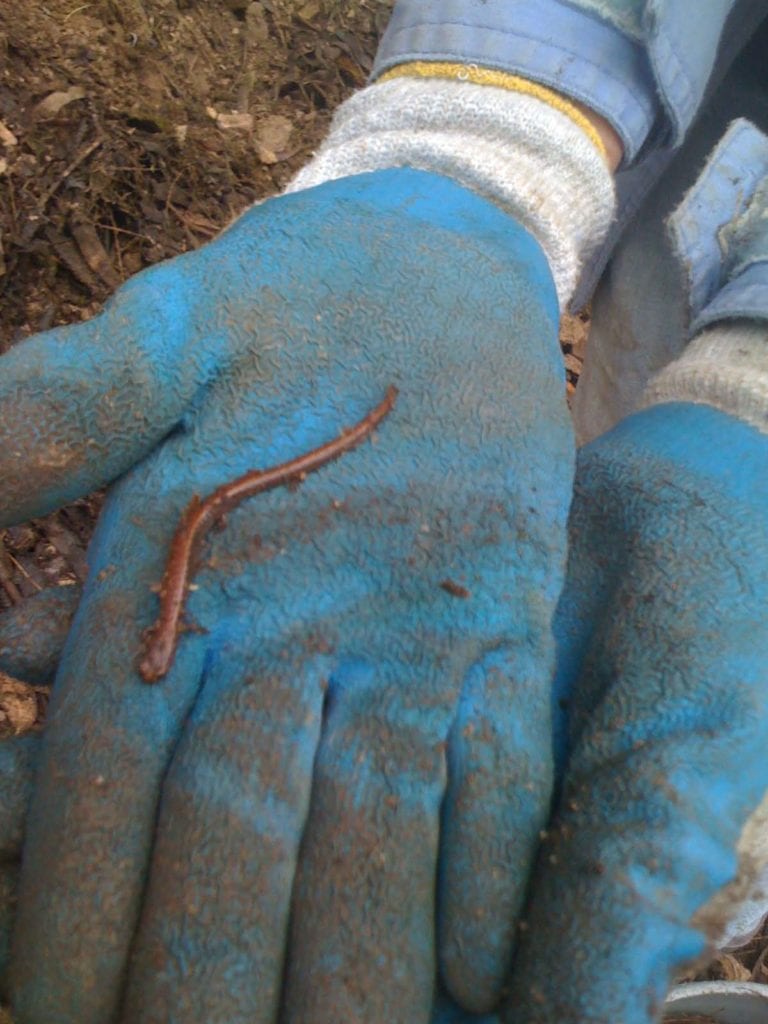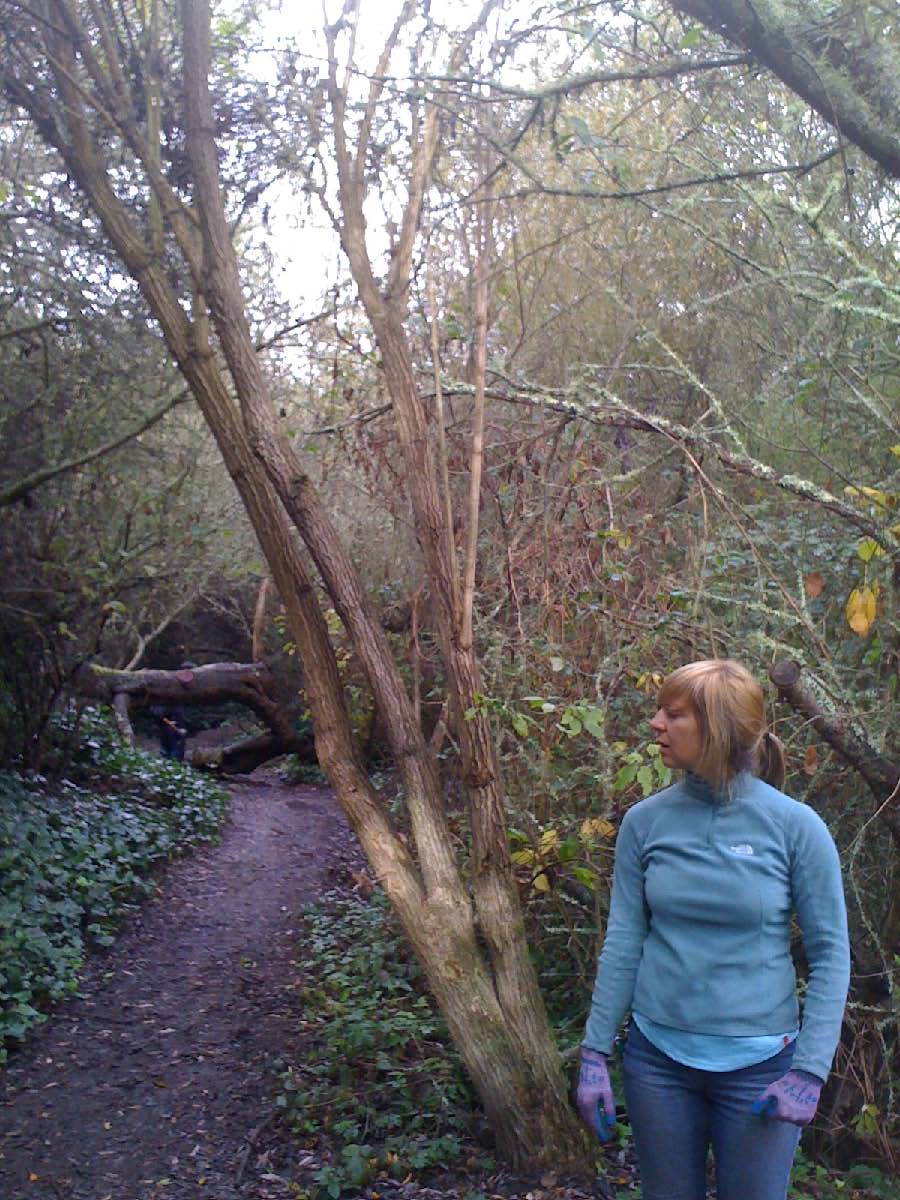

By Murray Schneider
Unlike past Wednesdays when pulling hillside thistle or pushing back Cape ivy on canyon slopes were the order of the day, on October 31 three Friends of Glen Canyon Park volunteers simply took an amble around Willow Creek Trail. It was a Halloween stroll in the park, ending in a lazy loop around Islais Creek. Nevertheless, the volunteers took several familiar tools with them.
Supervised by Jenny Sotelo, a staff member of Recreation and Park’s Natural Area Program, the trio began at the start of Banana Slug Way, a washboarded path paralleling Alms Road, named by Glenridge Co-Op children years earlier because banana slugs crawl along it.

The volunteers carried loppers, mattocks and hand clippers and trailed behind Glenridge parents who escorted their children along the rutted trail. Eucalyptus trees towered above them and along the creek willow leaves bent beneath sponges of morning fog.
It was Halloween and some of the kids were dressed in costumes. One of the children pulled from her mother’s grasp, digging in his heels, preventing the volunteers from moving by. “Come on,” his mother pleaded, “don’t you want to see your friends?”
It was perfect weather to see the trail’s namesakes too, some of which inched along the edges of the path in somnolent slow motion or stretched languidly, camouflaged among eucalyptus duff.
“What we want to do,” said Jenny Sotelo, “is look for French broom.” Glen Canyon is typical of the Bay Area Franciscan biological region, sometime called Franciscan landscape, a unique home to many species of plants and animals, some of which have never lived anywhere else.
Created in the mid-1990s by the Recreation and Park Commission, the NAP’s mission is to protect significant natural resources areas such as 70-acre Glen Canyon whose biological diversity is threatened by invasive non-native plants.
While not all non-native plants create a problem, a handful possesses traits that allow them to spread at an exponential rate. French boom is one such invasive. “French broom thickets can become overgrown and hinder trail paths if not pruned,” said Lisa Wayne, Manager of the Natural Areas Program, who is beginning preparations to oversee trail improvements funded by a 2008 bond measure.

Found in European Mediterranean climates, French broom was once used as roof thatching, fencerows and cattle fodder. A shrub that has the potential to grow as large as a small tree, French broom came to California in the 1850s as an ornamental plant, but now, left to its own devices, can invade coastal scrub, oak woodlands and grasslands. Such adaptation allows it to spread across open space, creating a monoculture that threatens habitat nurturing insects, birds and other animal species dependent on the diversity of native plants for food and shelter.
Trained to identify the invasive, which was once used to make medieval brooms, the three canyon volunteers studied the slope, ready to dispatch it as handily as the San Francisco Giants swept the Detroit Tigers several days before. “Look at the broom,” said Jean Conner, as she dropped to one knee and began tugging at the root crown. French broom can be difficult to extricate and requires considerable exertion.
Sotelo carried a yellow pop-up bag and Conner, who lives on Sussex Street, placed the shrubs into it. Seeds of broom can remain viable in soil banks for decades and resprouting is a common occurrence.
The group continued on. A mother, returning from Glenridge who boasted a pair of devilish Halloween horns, passed on the right, not far from the Ticket Tree, a eucalyptus fashioned into a V at its trunk. Glenridge kids commonly walk through the V, placing a eucalyptus leaf on the tree and make a wishes.
On the creek side of the trail, a copse of scraggly Himalayan blackberry clumped in a thorny mass, intruding over the path. Mary Huizinga, who lives on Laidley Street, approached with caution. Wielding a pair of hand clippers, she stuck her arm among the stiletto sharp stalks and clipped several back.
“Leaves of five, don’t let them thrive, leaves of three let them be,” Huizinga said, distinguishing between invasive Himalayan and native California blackberry. She resumed her jousting, poking her arm among thick strands, dodging the shark-tooth shaped thorns. Farther back, listing toward the dry creek bed, a jigsaw puzzle of intertwined stalks made bold commas, arching and curving until they became indistinguishable with more benign foliage.
“This is like emptying an ocean with a teaspoon,” said Huizinga, her clippers competing with the chirping of songbirds settling above her. Across the path a banana slug idled. Oversized and luminescent, it remained still as Conner turned her attention to hemlock.
Mary Huizinga walked across the narrow path, bent and lent a hand. “Hemlock is invasive,” she said. “And poisonous.” Poison hemlock is a biennial plant, three to eight feet tall, with a smooth red-purple spotted stem. Hemlock resembles the leaves of parsley and fennel. It’s not certain why Poison hemlock was introduced to California, but it’s clear the ancient Greeks used it to deal with convicted criminals.
“Poison hemlock is a species that can be harmful if ingested,” said Lisa Wayne. “So it is not safe for it to be alongside trails where humans and their pets frequently travel.” The plant is usually easy to uproot by hand when the soil is moist, which was the case since the morning fog had yet to dissipate.
Unearthing several plants, Conner found a newt, the size of a bait worm snuggled beneath a carpet of wet moss. Often found near creeks and streams, the amphibian had yet to develop. Conner picked it up, placing it on her blue glove. Still young, this newt dines on a smorgasbord of earthworms, snails and banana slugs that find homes alongside Islais Creek.
Before reaching the bunker-like building that houses Glenridge, the volunteers spotted patches of erharta, a mat forming perennial grass that is native to South Africa. It tends to grow along streams and fog drips, forming usurping underground root mats that impede native plant growth.
Joined by Steve Uchida, a retired postal worker who lives on Monterey Boulevard, Huizinga and Conner began removing it. The slightest shake can spread inimical seeds that germinate with alacrity, so they were careful to place the uprooted grass in the pop-up bag for removal off site.
The group moved along the trail by a split rail fence built by Friends of Glen Canyon Park that protects NAP and Friends reintroduced California native plants and trees necessary for the health and well being of insects and wildlife.
On the east side of the fence they stopped next to a blue elderberry that arched over the trail. Jenny Sotelo, a recent addition NAP ranks, gave it an approving look. “Jean planted it 10 or 12 years ago,” volunteered Mary Huizinga about Conner, the longest tenured member of Friends of Glen Canyon Park. Modest to a fault, you’d never hear such an admission from Conner.
Now devoid of its spring creamy flowers, the elderberry, which is found from British Columbia to Baja California, attracts legions of pollinators who are drawn to its petals and pinwheeling songbirds which consume its pale blue berries each summer. Ripened berries are edible and early Californians used them for making jam and pie, and California native-Americans called the blue elderberry the music tree because they made flutes from its young branches after removing the pith.
Conner appraised the tree. “It’s already sending out buds.” The group walked on, ducking beneath a low lying willow limb, crossing over a railroad tie-shaped log Friends of Glen Canyon positioned over the creek and rounded a curve. Before them stood a chert outcropping that rock climbers scale and generations of Silver Tree summer campers dubbed Minnie Ha Ha’s rock because legend has it an Ohlone Indian princess jumped from it in a tragic fit of unrequited love.
The volunteers stopped and listened. A flock of a dozen or so songbirds serenaded, calling and moving from tree to tree. It was late October and the birds didn’t need a whole lot of water. They sounded like giddy high school girls chattering before the Senior Prom.
“Must be bushtits,” said Huizinga, a veteran of Friends of Glen Canyon sponsored bird walks. Bushtits weave nests shaped like pouches or socks and hang from tree branches, often upside down like acrobatic circus trapeze catchers, scouting for insects and spiders that crawl on the underside of leaves.
The volunteers paraded into the open and stopped by the retaining wall across from Glenridge. Wrinkled scrubland and parched grassland, ready to turn green as the rainy season approached greeted them. Closing in on 11 o’clock, they stopped at the NAP truck and deposited their tools in its flatbed. Near the Ferry Building another parade, one million strong, began its motorcade along Market Street and the volunteers were anxious to get home.
The day was abbreviated, but productive. The Natural Areas Program is understaffed and relies on stewards such as the Friends of Glen Canyon Park volunteers to bolster its ranks. Their contribution neither goes unnoticed nor unappreciated.
“French broom and hemlock,” said Lisa Wayne, “can become threats to the local biodiversity and when left alone they can destroy native plants and the diverse plant assemblages in the area.”
Anyone wishing to volunteer with the Natural Areas Program can contact Joe Grey at 415-831-6328 or e-mail at joe.grey@sfgov.org or telephone Jean Conner, Friends of Glen Canyon Park, at 415-584-8576